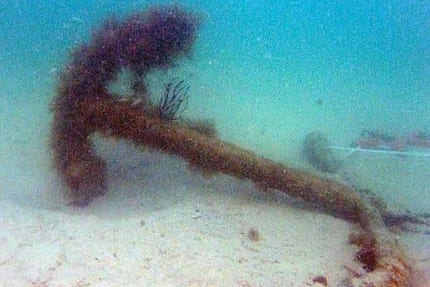EGMONT KEY – Underwater and underground at Egmont Key, mystery and history have intertwined since the mid-1800s.
Just off the northern tip of Anna Maria Island, which has bathed in its lighthouse beam since 1858, Egmont Key is mostly deserted, populated only by a lighthouse keeper, a few on-duty harbor pilots, a family of gopher tortoises and flocks of migrating shorebirds.
The voice of Capt. Robert E. Lee echoes on Egmont, which he surveyed in 1849. Lt. Col. Teddy Roosevelt’s unmistakable voice echoes there, too, among the ruins of Fort Dade, where he and his Rough Riders were stationed before leaving for Cuba in the Spanish-American War.
Cries of Indians, slaves and other prisoners are forever embedded in the thick walls of the jail cells still standing at the fort, whose cannons once aimed westward at unseen enemies.
Two cemeteries, one underground and one underwater, hold the silent remains of Seminole Indians whose identities are protected by their tribe, a descendant of a famous Pilgrim, Navy men lost to yellow fever, and nine children.
The waters around the key have silent tales to tell, too.
Ship’s log
It was the second year of the Civil War, 1863, when the Mary Cook was launched in New York.

The 82-foot, wooden-hulled tug traveled south in the Atlantic Ocean and into the Gulf of Mexico at an average 6 miles per hour, on her way to New Orleans to join the U.S. Navy.
There, she was rechristened the U.S.S. Narcissus in 1864. Armed with a 12-pound cannon and a 20-pound rifle, she began blockading ships that were carrying food and supplies to Southern troops, capturing enemy vessels, transporting prisoners and serving as a towboat.
In August, 1864, she served in the battle of Mobile Bay, during which Union Rear Admiral David G. Farragut spoke his infamous quote, “Damn the torpedoes! Full speed ahead!”
Then came Dec. 7, an infamous date long before World War II. In Mobile Bay, a storm arose and the Narcissus struck a mine, known then as a torpedo. It tore a hole in her starboard side amidships. She sank in 15 minutes. The crew survived.
The Navy refloated her, sending the Narcissus to Pensacola for repairs, where she sat out the rest of the war.
In 1865, with the war over, Narcissus began her voyage back to New York with the U.S.S. Althea to be decommissioned and sold. But on Jan. 4, 1866, another storm struck, this one near Anna Maria Island.
Althea headed northwest while Narcissus took a western route, taking the wind and tide on her starboard beam.
At 6:15 p.m. Narcissus signaled with a flare, which Althea returned at 6:30 p.m. At 7 p.m. Althea saw another signal from Narcissus, and responded.
But Narcissus gave no more signals. She ran aground on a sandbar off Egmont Key, and her boiler exploded, sinking the ship.
The next morning, Althea anchored off Egmont Key and saw wreckage from Narcissus, and the body of one of the crew, on the beach.
For two days Althea searched for survivors, but found none. The crew of 26 was gone.

Preserved
Nearly 150 years later, the submerged tomb lies in pieces in 15 feet of water about 2.7 miles northwest of Egmont Key, the engine, shaft, propeller and fragments of the exploded boiler visible among the wreckage.
On Jan. 20, the Narcissus became Florida’s 12th underwater archeological preserve in an underwater ceremony televised live at the Florida Aquarium in Tampa, which nominated the site for preserve status in 2010 with South Eastern Archaeological Services.
The preserve is now a recreational diving and snorkeling site, a heritage tourism site reflecting local maritime heritage and an ecotourism site due to its marine habitat, according to a report by the Florida Department of State Division of Historical Resources Bureau of Archaeological Research, which compiled the details of the ship’s history.
Narcissus is still owned by the U.S. Navy, and is protected by Florida laws prohibiting unauthorized disturbance, excavation or removal of artifacts. As a military grave, the Navy requests that the site be treated with respect.
For more information, including a virtual underwater tour, dive guide, photographs of ship’s artifacts and more, visit http://www.museumsinthesea.com/narcissus.
U.S.S. Narcissus timeline
- Launched in July 1863 in Albany, New York
- Purchased by the U.S. Navy under the name Mary Cook in September 1863
- Sent from New York to New Orleans in January 1864 to report to Rear Admiral David G. Farragut for duty in the West Gulf Blockading Squadron
- Commissioned into the U.S. Navy in New York City in February 1864
- Served in operations in Mississippi Sound, New Orleans and Pensacola as a blockader, dispatch vessel, prisoner transport and towboat
- Served near Fort Morgan during the Union victory at the battle of Mobile Bay in August 1864
- Struck a torpedo on Dec. 7, 1864 in Mobile Bay, sinking in 15 minutes with no loss of life
- Refloated in December 1864 and brought to the Pensacola Naval Yard for repairs
- June 1865 returned to Mobile Bay
- Acting Rear Admiral Henry Knox Thatcher decided Narcissus was no longer needed in October 1865
- Narcissus began voyage to New York to be decommissioned and sold on Jan. 1, 1866
- Narcissus was lost in a storm off Egmont Key on Jan. 4, 1866
Source: Florida Department of State Division of Historical Resources Bureau of Archaeological Research
































